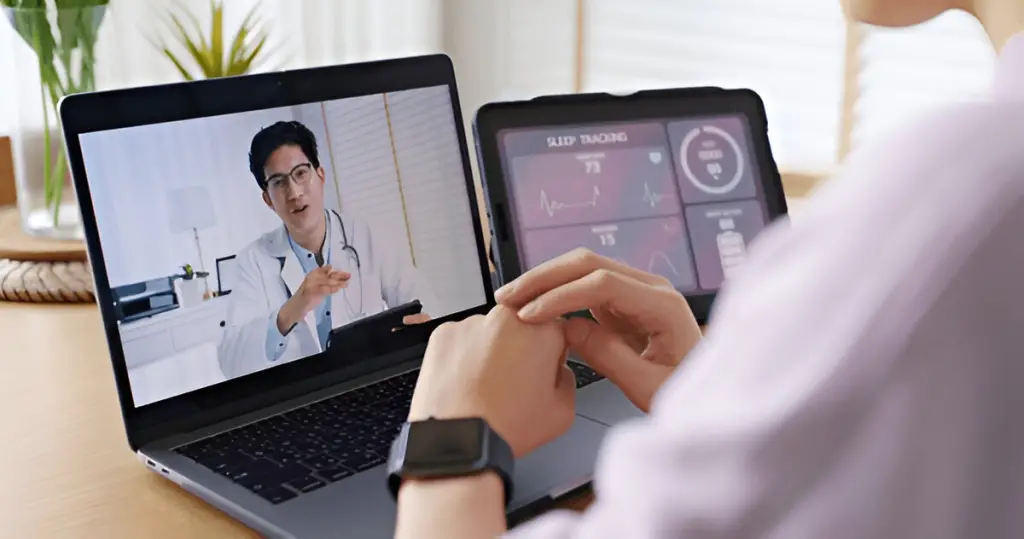Medicaid telehealth coverage has expanded dramatically since the onset of the COVID-19 pandemic. Many people wonder what virtual services their plan covers now. This guide explains everything you need to know about accessing telehealth through Medicaid today.
You’ll learn which services qualify for coverage and reimbursement. We’ll show you how to easily find Medicaid telehealth providers. You’ll discover how doctor telehealth Medicaid reimbursement actually works. We’ll explain how to add telehealth to Medicaid plan options. This comprehensive guide covers state expansions, billing codes, and claim processes.
By the end, you’ll understand precisely how to use telehealth benefits. Getting virtual care through Medicaid is easier than you think.
Table of Contents
Understanding Medicaid Telehealth Coverage

Medicaid now covers many telehealth services across all states. The coverage expanded dramatically during the COVID-19 pandemic period. Most states made these changes permanent for ongoing patient care.
What Telehealth Services Are Covered
Medicaid telehealth providers can offer several types of virtual care. These services help patients receive treatment safely at home. Here’s what’s typically included in your coverage:
| Service Type | Description | Coverage Status |
| Video visits | Face-to-face consultations with doctors | Widely covered |
| Phone consultations | Voice-only medical appointments | Most states |
| Remote monitoring | Health tracking through devices | Expanding coverage |
| Mental health therapy | Counseling and psychiatric services | Fully covered |
| Specialty consultations | Expert opinions via video | State-dependent |
Permanent vs. Temporary Telehealth Provisions
Many telehealth changes started as emergency measures during the COVID-19 pandemic. Some provisions became permanent parts of Medicaid coverage nationwide. Others may end when emergency declarations officially expire.
Permanent Changes:
- Mental health and substance abuse telehealth services
- Chronic disease management through virtual visits
- Preventive care consultations via video calls
Temporary Provisions:
- Expanded provider types allowed to bill telehealth
- Relaxed location requirements for patient visits
- Simplified enrollment processes for new telehealth providers
Complete Guide to Finding In-Network Telehealth Providers

Finding in-network Medicaid telehealth providers requires systematic searching. Each state maintains different provider databases and systems. Following the proper steps ensures you find covered providers.
Step 1: Identify Your Medicaid Plan Type
- Traditional fee-for-service Medicaid coverage
- Medicaid managed care organization (MCO) plan
- Dual eligible special needs plans (D-SNPs)
Step 2: Access Your State’s Official Provider Directory
- Visit your state Medicaid website directly
- Look for “Find a Provider” or “Provider Directory”
- Select “Telehealth Services” as a filter option
Step 3: Use Advanced Search Filters
| Filter Type | Purpose | Example |
| Location | Find providers near you | Within 25 miles |
| Specialty | Specific medical needs | Cardiology, Mental Health |
| Telehealth | Virtual service availability | Video, Audio, Both |
| Language | Communication preference | Spanish, ASL |
| New Patients | Accepting new members | Yes/No filter |
Complete 50-State Provider Search Directory

How to Use State Provider Directories

Step 1: Access Your State Portal
- Click your state’s website link above
- Look for “Find a Provider” or “Provider Directory”
- Create an account if required for advanced features
Step 2: Filter for Telehealth Services
- Select “Telehealth” or “Virtual Services” filter
- Choose service type (video, audio, monitoring)
- Set location radius for hybrid care options
Step 3: Verify Provider Information
- Call the provider’s office before scheduling appointments
- Confirm they accept your specific Medicaid plan
- Ask about technology requirements for virtual visits
- Check appointment availability and wait times
Important Notes:
- Website URLs may change; search “[State] Medicaid providers” if links don’t work
- Some states use managed care organization directories
- Rural states often have specialized telehealth networks
- Border states may offer cross-state provider options
MCO-Specific Provider Networks
Major Medicaid Managed Care Organizations:
| MCO Name | Coverage States | Telehealth Portal |
| Anthem | 14 states | Anthem Provider Finder |
| Centene | 29 states | Centene Find Care Tool |
| Molina | 15 states | Molina Provider Directory |
| UnitedHealth | 27 states | UHC Provider Search |
| Aetna | 22 states | Aetna Better Health Portal |
Verification Steps for Provider Selection
Before Scheduling Your First Appointment:
- Call the provider’s office to confirm telehealth availability
- Verify they accept your specific Medicaid plan
- Ask about technology requirements for virtual visits
- Confirm appointment scheduling process and wait times
- Check if prior authorization is required
Documentation to Have Ready:
- Medicaid identification card or number
- List of current medications and dosages
- Previous medical records or test results
- Emergency contact information and preferences
Complete Billing and Claim Codes Walk-Through

Healthcare providers use specific codes when billing Medicaid telehealth. Understanding these codes helps you know coverage limits. Each code type serves different virtual care purposes.
Primary Telehealth Billing Code Categories
Evaluation and Management (E&M) Codes with Telehealth:
| Code Range | Service Description | Modifier Required |
| 99201-99205 | New patient office visits | GT or 95 |
| 99211-99215 | Established patient visits | GT or 95 |
| 99241-99245 | Outpatient consultations | GT or 95 |
| 99251-99255 | Inpatient consultations | GT or 95 |
| 99281-99285 | Emergency department visits | GT or 95 |
Audio-Only Telehealth Codes
Phone Consultation Codes:
| CPT Code | Provider Type | Time Range | Coverage Status |
| 99441 | Physician | 5-10 minutes | Most states |
| 99442 | Physician | 11-20 minutes | Most states |
| 99443 | Physician | 21-30 minutes | Most states |
| 98966 | Non-physician | 5-10 minutes | Limited states |
| 98967 | Non-physician | 11-20 minutes | Limited states |
| 98968 | Non-physician | 21-30 minutes | Limited states |
Mental Health Telehealth Codes
Behavioral Health Specific Codes:
| Code | Service Description | Session Length | Special Notes |
| 90791 | Psychiatric diagnostic evaluation | 60 minutes | Initial assessment |
| 90834 | Psychotherapy | 45 minutes | Individual therapy |
| 90837 | Psychotherapy | 60 minutes | Extended session |
| 90847 | Family therapy | 50 minutes | Multiple participants |
| 90853 | Group therapy | 60 minutes | Per participant billing |
Remote Patient Monitoring Codes
RPM Billing Code Structure:
| Code | Activity | Billing Frequency | Requirements |
| 99453 | Device setup | Once per episode | Patient training |
| 99454 | Device supply | Monthly | 16+ days of data |
| 99457 | Physician analysis | Monthly | 20+ minutes |
| 99458 | Additional physician time | Monthly | Every 20 minutes |
| 99091 | Data interpretation | Monthly | Complex analysis |
Modifier Requirements and Usage
Essential Telehealth Modifiers:
GT Modifier: Synchronous telecommunications system
- Required for real-time video consultations
- Must be a live audio and video connection
- Used with most E&M codes
95 Modifier: Synchronous telemedicine service
- Alternative to the GT modifier in some states
- Indicates real-time telehealth service delivery
- Preferred by some Medicaid programs
GQ Modifier: Asynchronous telecommunications system
- Used for store-and-forward telehealth services
- Common in radiology and dermatology consultations
- Limited acceptance in most Medicaid programs
Claim Submission Process Walk-Through
Step 1: Service Documentation Requirements
- Patient consent for telehealth services recorded
- Technology platform and connection quality documented
- Clinical notes match in-person visit standards
- Location of patient during service noted
Step 2: Coding and Billing Preparation
- Select an appropriate CPT (Current Procedural Terminology) and HCPCS (Healthcare Common Procedure Coding System) code
- Add required telehealth modifier (GT or 95)
- Include diagnosis codes (ICD-10) as usual
- Note the place of service code changes
Step 3: Claim Form Completion
| Field | Standard Entry | Telehealth Entry |
| Place of Service | 11 (Office) | 02 (Telehealth) |
| Modifier | None | GT or 95 |
| Units | 1 | 1 |
| Charges | Standard rate | Same or adjusted |
Step 4: Common Rejection Reasons and Solutions
- Missing Modifier: Add GT or 95 modifier
- Wrong Place of Service: Use code 02 or 10
- Invalid Code Combination: Check state-specific rules
- Documentation Issues: Ensure consent and notes are complete
Step 5: Reimbursement Timeline
- Electronic claims: 14-21 days typical processing
- Paper claims: 30-45 days processing time
- Appeals process: 30-60 days for disputes
- State variations: Check specific timelines
Prior Authorization Requirements
Services Requiring Prior Auth:
- High-cost specialty telehealth consultations
- Multiple telehealth visits per week
- Certain mental health telehealth services
- Remote patient monitoring equipment setup
Documentation for Authorization:
- The medical necessity justification is written clearly
- Treatment plan including telehealth components
- Expected duration and frequency of services
- Alternative treatment options considered and rejected
State Telehealth Expansions Post-COVID

Every state expanded telehealth coverage significantly during the pandemic. These changes transformed how Medicaid delivers healthcare services. Most expansions became permanent parts of state programs.
Comprehensive State-by-State Expansion List
Northeast Region
| State | Primary Expansion | Status |
| Connecticut | Audio-only visits for established patients | Permanent |
| Maine | Frontier region coverage expansion | Permanent |
| Massachusetts | Specialist consultations via telehealth | Permanent |
| New Hampshire | Cross-state telehealth with Vermont | Permanent |
| New Jersey | Urban density telehealth programs | Permanent |
| New York | Audio-only visits, mental health expansion | Permanent |
| Pennsylvania | Coal mining community programs | Permanent |
| Rhode Island | Coastal community telehealth services | Permanent |
| Vermont | Rural mountainous region coverage | Permanent |
Southeast Region
| State | Primary Expansion | Status |
| Alabama | Mental health and substance abuse | Permanent |
| Delaware | Cross-border telehealth agreements | Permanent |
| Florida | Increased reimbursement rates | Permanent |
| Georgia | Rural telehealth hubs statewide | Permanent |
| Kentucky | Opioid treatment via telehealth | Permanent |
| Louisiana | Hurricane disaster protocols | Permanent |
| Maryland | Urban underserved neighborhoods | Permanent |
| Mississippi | Delta region rural expansion | Permanent |
| North Carolina | Tobacco farming communities | Permanent |
| South Carolina | Agricultural telehealth programs | Permanent |
| Tennessee | Music industry worker programs | Permanent |
| Virginia | Military base coordination | Permanent |
| West Virginia | Coal mining telehealth programs | Permanent |
Midwest Region
| State | Primary Expansion | Status |
| Illinois | Home-based visits, mental health | Permanent |
| Indiana | School-based rural programs | Permanent |
| Iowa | Agricultural worker programs | Permanent |
| Kansas | Native American reservation coverage | Permanent |
| Michigan | Great Lakes cross-border agreements | Permanent |
| Minnesota | Cold weather emergency protocols | Permanent |
| Missouri | Agricultural community services | Permanent |
| Nebraska | Agricultural services expansion | Permanent |
| North Dakota | Oil worker telehealth programs | Permanent |
| Ohio | Manufacturing worker programs | Permanent |
| South Dakota | Ranch and farming services | Permanent |
| Wisconsin | Dairy farming community services | Permanent |
Southwest Region
| State | Primary Expansion | Status |
| Arizona | Expanded provider types | Permanent |
| Arkansas | Home-based telehealth visits | Permanent |
| Nevada | Mining community services | Permanent |
| New Mexico | Tribal and rural integration | Permanent |
| Oklahoma | Tribal nation sovereignty agreements | Permanent |
| Texas | All provider types, rural coverage | Permanent |
West Region
| State | Primary Expansion | Status |
| Alaska | Audio-only visits for rural patients | Permanent |
| California | Mental health parity, chronic care | Permanent |
| Colorado | Behavioral health in all age groups | Permanent |
| Hawaii | Inter-island coverage expansion | Permanent |
| Idaho | Pharmacy consultations permanent | Permanent |
| Montana | Tribal programs across reservations | Permanent |
| Oregon | Forest worker services expansion | Permanent |
| Utah | Community telehealth integration | Permanent |
| Washington | Tech worker programs expansion | Permanent |
| Wyoming | Ranch worker programs expansion | Permanent |
Mental Health & Behavioral Services
- Alabama, California, Colorado, Illinois, New York
- Focus on therapy, counseling, and psychiatric services
- Permanent coverage for all age groups
Rural & Agricultural Communities
- Iowa, Missouri, Nebraska, South Dakota, Wisconsin, Wyoming
- Specialized programs for farming and ranching communities
- Remote area connectivity improvements
Industrial & Occupational Health
- North Dakota, Ohio, Pennsylvania, Nevada, West Virginia
- Worker-specific telehealth programs
- Industry-focused healthcare delivery
Tribal & Native American Services
- Kansas, Montana, New Mexico, Oklahoma
- Sovereignty agreements and specialized programs
- Cultural competency integration
Cross-Border & Regional Coordination
- Delaware, Michigan, New Hampshire, Vermont
- Multi-state provider agreements
- Regional healthcare network expansion
How to Add Telehealth to a Medicaid Plan

Adding telehealth services to your existing plan is simple. Most Medicaid plans now automatically include these services. You don’t usually need to pay extra fees.
Steps to access telehealth:
- Check if your current plan covers telehealth
- Contact your managed care organization if needed
- Ask about any prior authorization requirements
- Schedule appointments with approved telehealth providers
- Download any required apps or software
Program Integrity and Quality Assurance
Medicaid ensures that telehealth services always meet quality standards. Programs monitor providers to prevent fraud and abuse. This protects both patients and taxpayer money effectively.
Monitoring and Compliance
States track telehealth usage patterns and billing practices. They look for unusual billing or inappropriate service delivery. Providers must follow the same standards as in-person care.
Expected Impact on Healthcare Costs
Telehealth can reduce overall healthcare spending for Medicaid. It often prevents expensive emergency room visits. Patients get care before conditions become more serious.
Cost Benefits:
- Reduced transportation costs for patients
- Lower overhead expenses for healthcare providers
- Fewer missed appointments due to accessibility
- Earlier intervention prevents costly complications
Frequently Asked Questions
Is telehealth covered under Medicaid?
Yes, Medicaid covers many telehealth services in all states. Coverage expanded significantly during COVID, and many changes stayed permanent.
What is included in telehealth services?
Telehealth includes video visits, phone consultations, remote monitoring, and mental health therapy. Coverage varies by state and provider type.
How do I access Medicare telehealth?
For Medicare telehealth, contact your doctor or Medicare plan. Check Medicare.gov for a list of covered services and approved providers in your area.
What does telehealth include?
Telehealth encompasses virtual doctor visits, mental health counseling, chronic disease management, and remote patient monitoring facilitated by technology.
Conclusion
Medicaid telehealth coverage offers convenient healthcare access for millions. Most states now provide comprehensive virtual care options permanently. You can easily find Medicaid telehealth providers through directories.
Understanding doctor telehealth Medicaid reimbursement helps you know coverage. Adding telehealth services to your plan is straightforward. State expansions have made virtual care more accessible. Billing codes ensure proper payment for telehealth services. Quality monitoring effectively protects patients and prevents fraud.
Telehealth reduces costs while significantly improving access to care. Take advantage of these services for better health outcomes.
